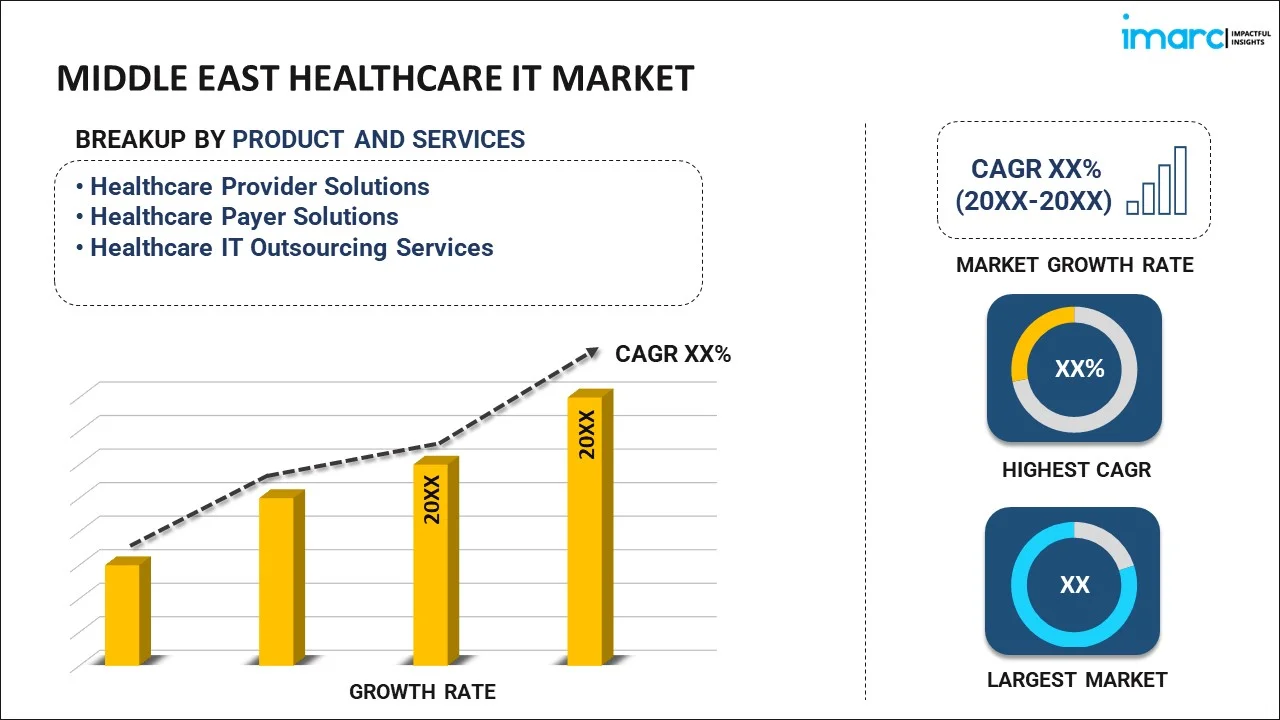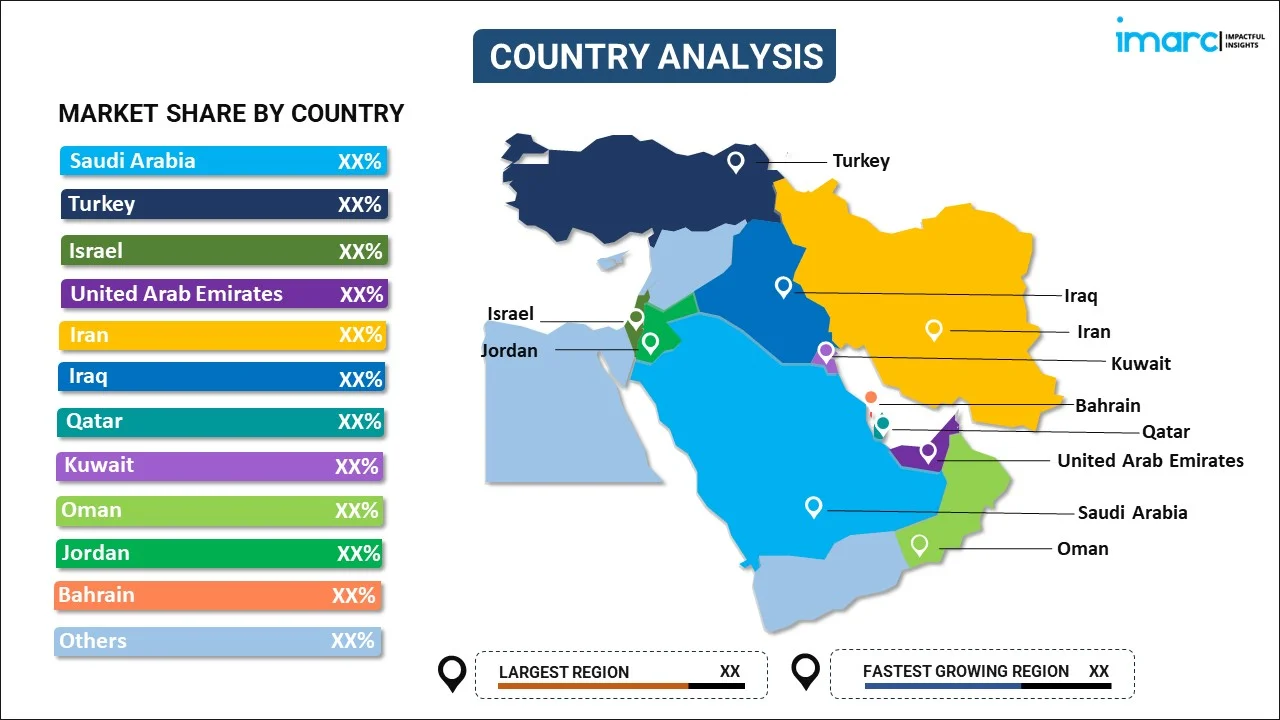
Middle East Healthcare IT Market Report by Product and Services (Healthcare Provider Solutions, Healthcare Payer Solutions, Healthcare IT Outsourcing Services), Component (Software, Hardware, Services), Delivery Modes (On-premises, Cloud-based), End User (Healthcare Providers, Healthcare Payers, and Others), and Country 2025-2033
Market Overview:
Middle East healthcare IT market size reached USD 13.4 Billion in 2024. Looking forward, IMARC Group expects the market to reach USD 43.2 Billion by 2033, exhibiting a growth rate (CAGR) of 12.83% during 2025-2033. The increasing shift towards value-based care models, where providers are reimbursed based on patient outcomes, is driving the market.
|
Report Attribute
|
Key Statistics
|
|---|---|
|
Base Year
|
2024
|
|
Forecast Years
|
2025-2033
|
|
Historical Years
|
2019-2024
|
|
Market Size in 2024
|
USD 13.4 Billion |
|
Market Forecast in 2033
|
USD 43.2 Billion |
| Market Growth Rate 2025-2033 | 12.83% |
Healthcare IT, or health information technology, refers to the use of technology to manage and exchange health information. It encompasses a broad range of tools and systems designed to enhance the efficiency and quality of healthcare delivery. Healthcare IT includes electronic health records (EHRs) for digital storage and retrieval of patient information, telemedicine for remote consultations, health information exchange (HIE) for sharing data among healthcare providers, and various software applications for tasks like billing and appointment scheduling. The integration of IT in healthcare aims to streamline processes, reduce errors, and improve patient outcomes. Additionally, it facilitates data analysis for medical research and population health management. As technology continues to advance, healthcare IT plays a crucial role in modernizing and optimizing healthcare systems to meet the evolving needs of patients and healthcare providers.
Middle East Healthcare IT Market Trends:
The healthcare IT market in the Middle East is experiencing unprecedented growth, primarily driven by the increasing demand for advanced technologies to enhance patient care and streamline healthcare processes. Moreover, the regional push towards digitization and the adoption of EHRs have become pivotal factors in propelling the healthcare IT market forward. As healthcare providers strive to improve operational efficiency and patient outcomes, the integration of IT solutions has become imperative. Furthermore, the rising prevalence of chronic diseases and the aging population are compelling healthcare organizations to invest in IT infrastructure for better disease management and preventive care. The intersection of healthcare and technology is underscored by the growing prominence of telehealth services, remote patient monitoring, and mobile health applications, all of which contribute to the market's upward trajectory. In addition to this, the continuous evolution of artificial intelligence and data analytics, which enable healthcare professionals to derive valuable insights for personalized medicine and predictive analytics, is expected to drive the healthcare IT market in the Middle East during the forecast period.
Middle East Healthcare IT Market Segmentation:
IMARC Group provides an analysis of the key trends in each segment of the market, along with forecasts at the regional and country levels for 2025-2033. Our report has categorized the market based on product and services, component, delivery mode, and end user.
Product and Services Insights:

- Healthcare Provider Solutions
- Clinical Solutions
- Nonclinical Healthcare IT Solutions
- Healthcare Payer Solutions
- Pharmacy Audit and Analysis Systems
- Claims Management Solutions
- Analytics and Fraud Management Solutions
- Member Eligibility Management Solutions
- Provider Network Management Solutions
- Billing and Accounts (Payment) Management Solutions
- Customer Relationship Management Solutions
- Population Health Management Solutions
- Others
- Healthcare IT Outsourcing Services
- Provider HCIT Outsourcing Services Market
- Payer IT Outsourcing Services
- Operational IT Outsourcing Services
The report has provided a detailed breakup and analysis of the market based on the product and services. This includes healthcare provider solutions (clinical solutions and nonclinical healthcare IT solutions), healthcare payer solutions (pharmacy audit and analysis systems, claims management solutions, analytics and fraud management solutions, member eligibility management solutions, provider network management solutions, billing and accounts (payment) management solutions, customer relationship management solutions, population health management solutions, and others), healthcare IT outsourcing services (provider HCIT outsourcing services market, payer IT outsourcing services, and operational IT outsourcing services).
Component Insights:
- Software
- Hardware
- Services
A detailed breakup and analysis of the market based on the component have also been provided in the report. This includes software, hardware, and services.
Delivery Mode Insights:
- On-premises
- Cloud-based
The report has provided a detailed breakup and analysis of the market based on the delivery mode. This includes on-premises and cloud-based.
End User Insights:
- Healthcare Providers
- Hospitals
- Ambulatory Care Centers
- Home Healthcare Agencies, Nursing Homes, and Assisted Living Facilities
- Diagnostic and Imaging Centers
- Pharmacies
- Healthcare Payers
- Private Payers
- Public Payers
- Others
A detailed breakup and analysis of the market based on the end user have also been provided in the report. This includes healthcare providers (hospitals, ambulatory care centers, home healthcare agencies, nursing homes, and assisted living facilities, diagnostic and imaging centers, and pharmacies), healthcare payers (private payers, public payers), and others.
Country Insights:

- Saudi Arabia
- Turkey
- Israel
- United Arab Emirates
- Iran
- Iraq
- Qatar
- Kuwait
- Oman
- Jordan
- Bahrain
- Others
The report has also provided a comprehensive analysis of all the major regional markets, which include Saudi Arabia, Turkey, Israel, United Arab Emirates, Iran, Iraq, Qatar, Kuwait, Oman, Jordan, Bahrain, and Others.
Competitive Landscape:
The market research report has also provided a comprehensive analysis of the competitive landscape in the market. Competitive analysis such as market structure, key player positioning, top winning strategies, competitive dashboard, and company evaluation quadrant has been covered in the report. Also, detailed profiles of all major companies have been provided.
Middle East Healthcare IT Market Report Coverage:
| Report Features | Details |
|---|---|
| Base Year of the Analysis | 2024 |
| Historical Period | 2019-2024 |
| Forecast Period | 2025-2033 |
| Units | Billion USD |
| Scope of the Report | Exploration of Historical Trends and Market Outlook, Industry Catalysts and Challenges, Segment-Wise Historical and Future Market Assessment:
|
| Product and Services Covered |
|
| Components Covered | Software, Hardware, Services |
| Delivery Modes Covered | On-premises, Cloud-based |
| End Users Covered |
|
| Countries Covered | Saudi Arabia, Turkey, Israel, United Arab Emirates, Iran, Iraq, Qatar, Kuwait, Oman, Jordan, Bahrain, Others |
| Customization Scope | 10% Free Customization |
| Post-Sale Analyst Support | 10-12 Weeks |
| Delivery Format | PDF and Excel through Email (We can also provide the editable version of the report in PPT/Word format on special request) |
Key Questions Answered in This Report:
- How has the Middle East healthcare IT market performed so far and how will it perform in the coming years?
- What has been the impact of COVID-19 on the Middle East healthcare IT market?
- What is the breakup of the Middle East healthcare IT market on the basis of product and services?
- What is the breakup of the Middle East healthcare IT market on the basis of component?
- What is the breakup of the Middle East healthcare IT market on the basis of delivery mode?
- What is the breakup of the Middle East healthcare IT market on the basis of end user?
- What are the various stages in the value chain of the Middle East healthcare IT market?
- What are the key driving factors and challenges in the Middle East healthcare IT?
- What is the structure of the Middle East healthcare IT market and who are the key players?
- What is the degree of competition in the Middle East healthcare IT market?
Key Benefits for Stakeholders:
- IMARC’s industry report offers a comprehensive quantitative analysis of various market segments, historical and current market trends, market forecasts, and dynamics of the Middle East healthcare IT market from 2019-2033.
- The research report provides the latest information on the market drivers, challenges, and opportunities in the Middle East healthcare IT market.
- Porter's five forces analysis assist stakeholders in assessing the impact of new entrants, competitive rivalry, supplier power, buyer power, and the threat of substitution. It helps stakeholders to analyze the level of competition within the Middle East healthcare IT industry and its attractiveness.
- Competitive landscape allows stakeholders to understand their competitive environment and provides an insight into the current positions of key players in the market.
Need more help?
- Speak to our experienced analysts for insights on the current market scenarios.
- Include additional segments and countries to customize the report as per your requirement.
- Gain an unparalleled competitive advantage in your domain by understanding how to utilize the report and positively impacting your operations and revenue.
- For further assistance, please connect with our analysts.
 Request Customization
Request Customization
 Speak to an Analyst
Speak to an Analyst
 Request Brochure
Request Brochure
 Inquire Before Buying
Inquire Before Buying




.webp)




.webp)












